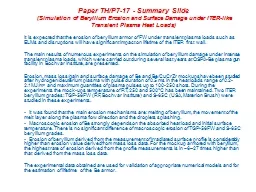

Simulation of Beryllium Erosion and Surface Damage under ITERlike Transient Plasma Heat Loads It is expected that the erosion of beryllium armor of FW under transient plasma loads such as ELMs and disruptions will have significant impact on lifetime of the ITER first wall ID: 912489
Download Presentation The PPT/PDF document "Paper TH/P7-17 - Summary Slide" is the property of its rightful owner. Permission is granted to download and print the materials on this web site for personal, non-commercial use only, and to display it on your personal computer provided you do not modify the materials and that you retain all copyright notices contained in the materials. By downloading content from our website, you accept the terms of this agreement.
Slide1
Paper TH/P7-17 - Summary Slide (Simulation of Beryllium Erosion and Surface Damage under ITER-like Transient Plasma Heat Loads)
It is expected that the erosion of beryllium armor of FW under transient plasma loads such as ELMs and disruptions will have significant impact on lifetime of the ITER first wall.
The main results of numerous experiments on the simulation of beryllium damage under intense transient plasma loads, which were carried out during several last years at QSPA-Be plasma gun facility in
Bochvar
Institute, are presented.
Erosion, mass loss/gain and surface damage of Be and Be/
CuCrZr
mockups
have been studied after hydrogen/deuterium plasma with pulse duration of 0.5
ms
in the heat
loads range of
0.2-2.1MJ/m
2
and maximum quantities of plasma pulses up to 100-250 shots.
During the
experiments
the mock-ups temperature of RT, 250 and 500°C has been maintained. Two
ITER beryllium
grades
: TGP-56FW (RF,
Bochvar
Institute) and S-65C (USA,
Materion
Brush) were studied in these experiments.
• It was found that the main erosion mechanisms are: melting of beryllium, the movement of the melt layer along the plasma flow direction and the droplets splashing.
• Macroscopic erosion of Be strongly depends on the absorbed heat load and initial surface temperature. There is no significant difference of macroscopic erosion of TGP-56FW and S-65C beryllium grades.
• Erosion of
beryllium
derived from the measurement of irradiated
surface
profile
is considerably higher than erosion value derived from mass loss data. For the mockup armored with beryllium, the highest rate of erosion derived from the profile measurements is
in
~6–27 times higher than that derived from the mass loss data.
The experimental data obtained are used for validation of appropriate numerical models and for the estimation of lifetime of the Be armor.